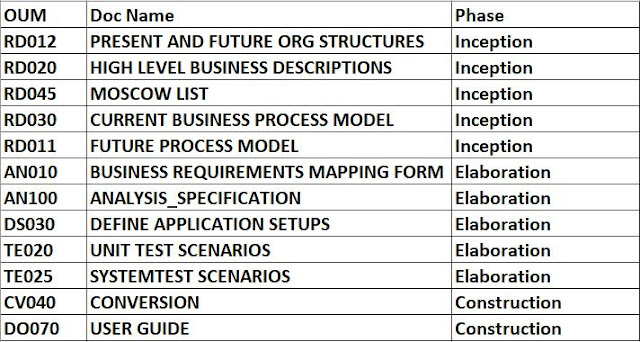Mandatory OUM documents for Oracle Cloud Implementation
Mandatory OUM documents for Oracle cloud Implementation
In this post we will see what are the mandatory/important OUM documents for oracle cloud implementation, which are required before we do any oracle cloud implementation.
What is Oracle Unified Methodology (OUM)?
OUM stands for Oracle Unified methodology. OUM contains set or documents/materials which supports the development and Implementation of oracle-based solutions. Oracle Unified methodology replaces oracles old AIM (Application Implementation Methodology).
In the dynamic landscape of Oracle Cloud implementations, success hinges not just on technical expertise but also on a robust, standardized methodology. The Oracle Unified Methodology (OUM) is Oracle's gold standard, guiding projects from inception to operation. While OUM itself is vast and adaptable, certain documentation artifacts are absolutely mandatory to ensure clarity, control, and successful project delivery, especially in the context of Oracle Cloud applications.
This comprehensive guide will not only list these essential OUM documents but will delve deeper into their purpose, key contents, responsible roles, and their relevance within specific OUM phases for Oracle Cloud implementations. Understanding these documents is crucial for project managers, functional consultants, technical leads, and stakeholders to navigate the complexities of cloud transformations effectively.
Below are the main five principle of Oracle Unified Methodology (OUM)
Business: It focuses on the business and provides assurance of stake holder acceptance and timely delivery of the development’s efforts.
Architecture: It makes sure the architecture is defined in well advance before the resources are committed for development and implementation work.
Adaptability: Encourages adaptability for scalable delivery across small and large projects possessing disparate resources and skill levels.
Implementation: It focuses on providing rapid implementation techniques to deliver business solutions in shorter time frames.
Standards: It basically extends the Unified Modeling Language and the Unified Software development process
Oracle Unified methodology(OUM) Implementation Workflow
Mandatory OUM documents for Oracle cloud Implementation
Before we do any Implementation/ support project for oracle we need to have some mandatory/Important documents which supports oracle based implementation/Support.
Below I have tried to list down the Minimum number of Mandatory/important OUM documents for oracle Implementation which are required before we start the oracle Implementation. Apart from these there are several other OUM documents which can we used as supporting documents.
List of mandatory OUM documents for oracle cloud implementation
Mandatory OUM documents for Oracle Implementation
Best Practices for OUM Document Management in Oracle Cloud Implementations
Effective documentation isn't just about ticking boxes; it's about enabling understanding, collaboration, and successful adoption.
- Start Early & Iterate Often: Don't wait until the last minute. Begin documenting requirements and design from day one. In agile Cloud projects, documents should evolve iteratively with each sprint.
- Ensure Stakeholder Buy-in: Mandatory documents often require client sign-off. Ensure all key stakeholders review and approve documents to prevent scope creep and rework.
- Maintain a Central Repository: Utilize a shared platform (e.g., SharePoint, Confluence, Oracle Content and Experience Cloud) for all project documents with clear version control. This ensures everyone has access to the latest approved versions.
- Focus on Clarity & Conciseness: While detailed, documents should be easy to understand. Avoid jargon where possible and use diagrams, flowcharts, and tables to convey complex information clearly.
- Link Related Documents: Establish clear traceability between documents (e.g., RDD to BPD to Test Scripts) to show how requirements are being met throughout the solution.
- Regular Reviews & Updates: Documents are living artifacts. Schedule regular review sessions and update them as requirements or designs evolve during the project lifecycle.
- Leverage Oracle Best Practices: For Cloud, prioritize configuring standard functionalities and adopt Oracle's recommended processes. This simplifies documentation and reduces customization efforts.
- Training & Knowledge Transfer: Ensure the client's internal team is trained on how to use and maintain these documents post-implementation, facilitating knowledge transfer and ongoing support.
Conclusion: Mastering OUM Documentation for Cloud Success
The Oracle Unified Methodology provides a robust framework, and its mandatory documents are the backbone of any successful Oracle Cloud implementation. By meticulously developing and managing these artifacts, project teams can ensure:
- Clarity and Alignment: A common understanding of scope, requirements, and design among all stakeholders.
- Risk Mitigation: Early identification and addressing of gaps, issues, and potential challenges.
- Quality Assurance: Verifying that the delivered solution meets business needs and performs optimally.
- Smooth Transition: Facilitating effective knowledge transfer and post-go-live support.












No comments:
Post a Comment